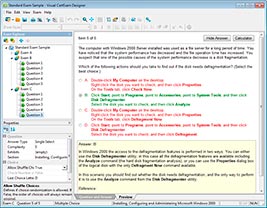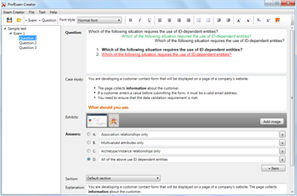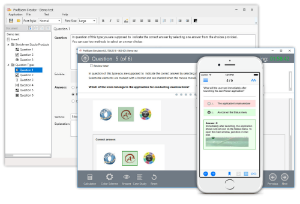Download VMware vSphere 8-x Professional.2V0-21.23.ExamTopics.2025-04-28.109q.vcex
| Vendor: | VMware |
| Exam Code: | 2V0-21.23 |
| Exam Name: | VMware vSphere 8-x Professional |
| Date: | Apr 28, 2025 |
| File Size: | 910 KB |
| Downloads: | 9 |
How to open VCEX files?
Files with VCEX extension can be opened by ProfExam Simulator.
Discount: 20%
Demo Questions
Question 1
An administrator is tasked with applying updates to a vSphere cluster running vSAN using vSphere Lifecycle Manager. Downtime to the ESXi hosts must be minimal while the work is completed.
The administrator has already completed the following steps and no errors have been returned:
- Downloaded all applicable software and created a new image.
- Attached the new image to the cluster and run a compliance check against the image for the cluster.
- Ran a remediation pre-check for the cluster.
Which two series of steps should the administrator perform to start the remediation of the cluster using the new image? (Choose two.)
- 1. Use the Remediate option in vSphere Lifecycle Manager to remediate all of the ESXi hosts in the cluster in parallel.2. Allow vSphere Lifecycle Manager to automatically control maintenance mode on the ESXi hosts.
- 1. Place each of the ESXi hosts into maintenance mode manually.2. Use the Stage option in vSphere Lifecycle Manager to stage the required software on all ESXi hosts one at a time.
- 1. Leave all ESXi hosts in the cluster operational.2. Use the Stage All option in vSphere Lifecycle Manager to stage the required software onto all ESXi hosts one at a time.
- 1. Leave all ESXi hosts in the cluster operational.2. Use the Stage All option in vSphere Lifecycle Manager to stage the required software onto all ESXi hosts in the cluster in parallel.
- 1. Use the Remediate option in vSphere Lifecycle Manager to remediate all of the ESXi hosts in the cluster in sequence.2. Allow vSphere Lifecycle Manager to automatically control maintenance mode on the ESXi hosts.
Correct answer: DE
Question 2
During the staging of a patch on a vCenter Server Appliance, an error was encountered and the process stopped. An administrator resolved the root cause and is ready to continue with the staging of the patch.
From the vCenter Management Interface, which action should the administrator take to continue the process from the point at which the error occurred?
- Use the Stage and Install option to resume the staging.
- Use the Resume option to resume the staging.
- Use the Unstage option to restart the staging.
- Use the Stage Only option to restart the staging.
Correct answer: B
Question 3
Refer to the exhibit.

An administrator set up the following configuration:
- The distributed switch has four ESXi hosts, and each host has two 10 Gbps NICs.
- In the Network I/O Control configuration, the amount of bandwidth reserved for virtual machine (VM) traffic if 4 Gbps.
The administrator wants to guarantee that VMs in the Retail distributed port group can access 50 percent of the available reserved bandwidth for VM traffic.
Given this scenario, what should the size (in Gbps) of the Retail network resource pool be?
- 40
- 32
- 8
- 16
Correct answer: D
Question 4
Refer to the exhibit.

An environment has the following configuration:
- Resource Pool “RP-MOM” has a reservation of 6GHz and one running virtual machine (VM) “VM-M1” with 1 GHz reserved.
- Resource Pool “RP-KID” has a reservation of 2GHz, and expandable reservations is activated.
The administrator creates two VMs, “VM-K1” and “VM-K2”, in the “RP-KID” resource pool with 2GHz reserved for each, and turns on “VM-M1.”
Given this scenario, which statement is true?
- The administrator must deactivate expandable reservations to turn on VM-K2.
- The administrator can create a third VM (“VM-K3”) at RP-KID and reserve 6GHz.
- VM-K2 can be powered on because it can get the resources needed from RP-MOM.
- VM-K2 cannot be powered on because there are not enough resources in RP-KID.
Correct answer: C
Question 5
Refer to the exhibit.

An administrator is tasked with adding new capacity to an existing software-defined data center (SDDC).
- The SDDC currently hosts two vSphere clusters (ClusterA and ClusterB) with different CPU compatibilities.
- vSphere vMotion and vSphere Distributed Resource Scheduler (DRS) are currently in use in the SDDC.
- The new capacity will be implemented by provisioning four ESXi hosts running a new generation of Intel Skylake CPUs.
- All workload virtual machines (VMs) must support live migration to any cluster in the SDDC.
The administrator noticed the running critical "evc1" virtual machine (VM) shown in the exhibit is not migrating using vSphere vMotion to the original Clusters A or B.
Which three steps must the administrator take to support this functionality? (Choose three.)
- Disable the Enhanced vMotion Compatibility (EVC) on the VM.
- Reboot the VM.
- Configure the Enhanced vMotion Compatibility (EVC) on the VM to Intel Skylake.
- Power on the VM.
- Configure the Enhanced vMotion Compatibility (EVC) on vSphere Cluster A and B to sup-port Intel Skylake.
- Power off the VM.
Correct answer: ADE
Question 6
An administrator has a requirement to revert a running virtual machine to a previous snapshot af-ter a failed attempt to upgrade an application. When the administrator originally took the snap-shot, the following choices in the Take Snapshot dialog were made:
- Snapshot the virtual machine’s memory = false
- Quiesce guest file system = false
What will be the result of the administrator selecting the “Revert to Latest Snapshot” option to return the virtual machine to a previous snapshot? (Choose two.)
- The virtual machine will be restored to the parent snapshot
- The virtual machine will be restored in a powered off state.
- The virtual machine will be restored to the child snapshot
- The virtual machine will be restored in a powered on state.
- The virtual machine will be restored in a suspended state.
Correct answer: AB
Question 7
An administrator is tasked with configuring certificates for a VMware software-defined data center (SDDC) based on the following requirements:
- The solution should minimize the ongoing management overhead of replacing certificates.
- No intermediate certificate authorities are allowed in the certificate chain.
- All external traffic should be secured using certificates signed by an Enterprise Certificate Authority (CA).
Which two actions should the administrator take to ensure the solution meets corporate policy? (Choose two.)
- Replace the solution user certificates with custom certificates generated from the Enterprise CA.
- Replace the machine SSL certificates with custom certificates generated from the Enterprise CA.
- Replace the machine SSL certificates with self-signed certificates generated from the VMware Certificate Authority (VMCA).
- Replace the VMware Certificate Authority (VMCA) certificate with a custom certificate gen-erated from the Enterprise CA.
- Replace the solution user certificates with self-signed certificates generated from the VMware Certificate Authority (VMCA).
Correct answer: AB
Question 8
An administrator is planning to upgrade a VMware vCenter instance to version 8. It is currently integrated with the following solutions:
- VMware Aria Operations for Logs
- VMware Aria Operations
Which tool can the administrator use to automatically detect interoperability between the solu-tions and eliminate any unwanted or unexpected results during the upgrade process?
- vSphere Update Manager
- vSphere Lifecycle Manager
- VMware Aria Suite Lifecycle
- vCenter Server Update Planner
Correct answer: D
Question 9
An administrator has a requirement to revert a running virtual machine to a previous snapshot af-ter a failed attempt to upgrade an application. When the administrator originally took the snap-shot, the following choices in the Take Snapshot dialog were made:
- Snapshot the virtual machine's memory = true
- Quiesce guest file system = false
Which two statements describe the result of the administrator selecting the "Revert to Latest Snapshot" option to return the virtual machine to a previous snapshot? (Choose two.)
- The virtual machine will be restored in a suspended state.
- The virtual machine will be restored in a powered off state.
- The virtual machine will be restored in a powered on state.
- The virtual machine will be restored to the parent snapshot.
- The virtual machine will be restored to the child snapshot.
Correct answer: CD
Question 10
Refer to the exhibit.

Given the configuration shown in the exhibit, what must the administrator do to delete only the latest version of the template?
- In the SA-Templates folder, rename App-LibTemplate (2) to App-LibTemplate (4).
- Check out App-LibTemplate (3) and delete the template from the SA-Templates folder.
- Delete App-LibTemplate (3) from the SA-Templates folder.
- Revert to App-LibTemplate (2) and delete App-LibTemplate (3).
Correct answer: B
Question 11
A VMkernel port is labelled PROD01 and uses the default TCP/IP stack.
Which configuration change should the administrator make to isolate long-distance vSphere vMotion migration traffic from other vSphere vMotion traffic?
- Create a new VMkernel port and set the TCP/IP stack to vMotion.
- Remove PROD01 and create a new VMkernel port with the TCP/IP stack set to vMotion.
- Modify PROD01 by changing the TCP/IP stack to provisioning.
- Remove PROD01 and create a new VMkernel port with the TCP/IP stack set to provisioning.
Correct answer: A
HOW TO OPEN VCE FILES
Use VCE Exam Simulator to open VCE files

HOW TO OPEN VCEX AND EXAM FILES
Use ProfExam Simulator to open VCEX and EXAM files


ProfExam at a 20% markdown
You have the opportunity to purchase ProfExam at a 20% reduced price
Get Now!




